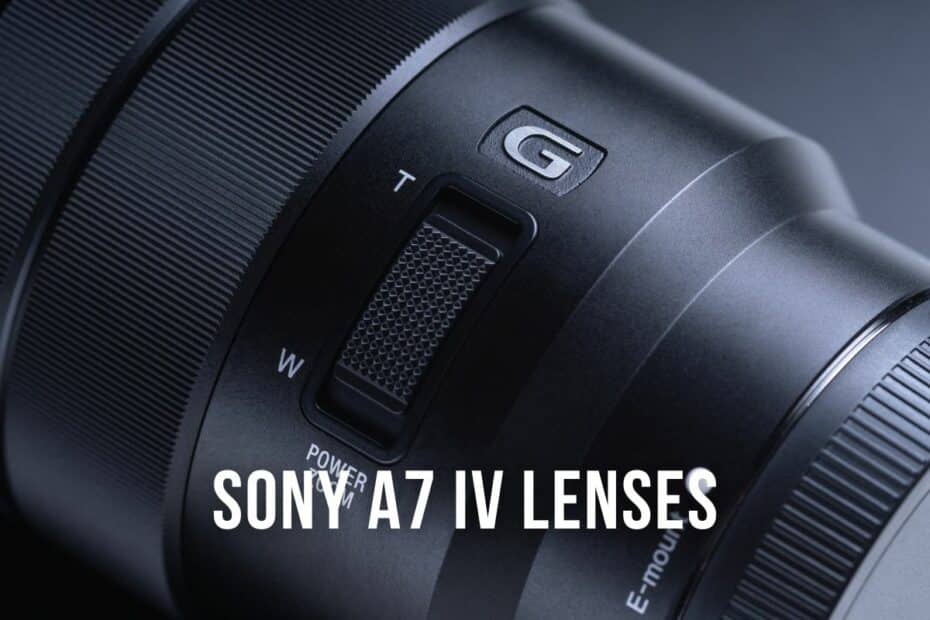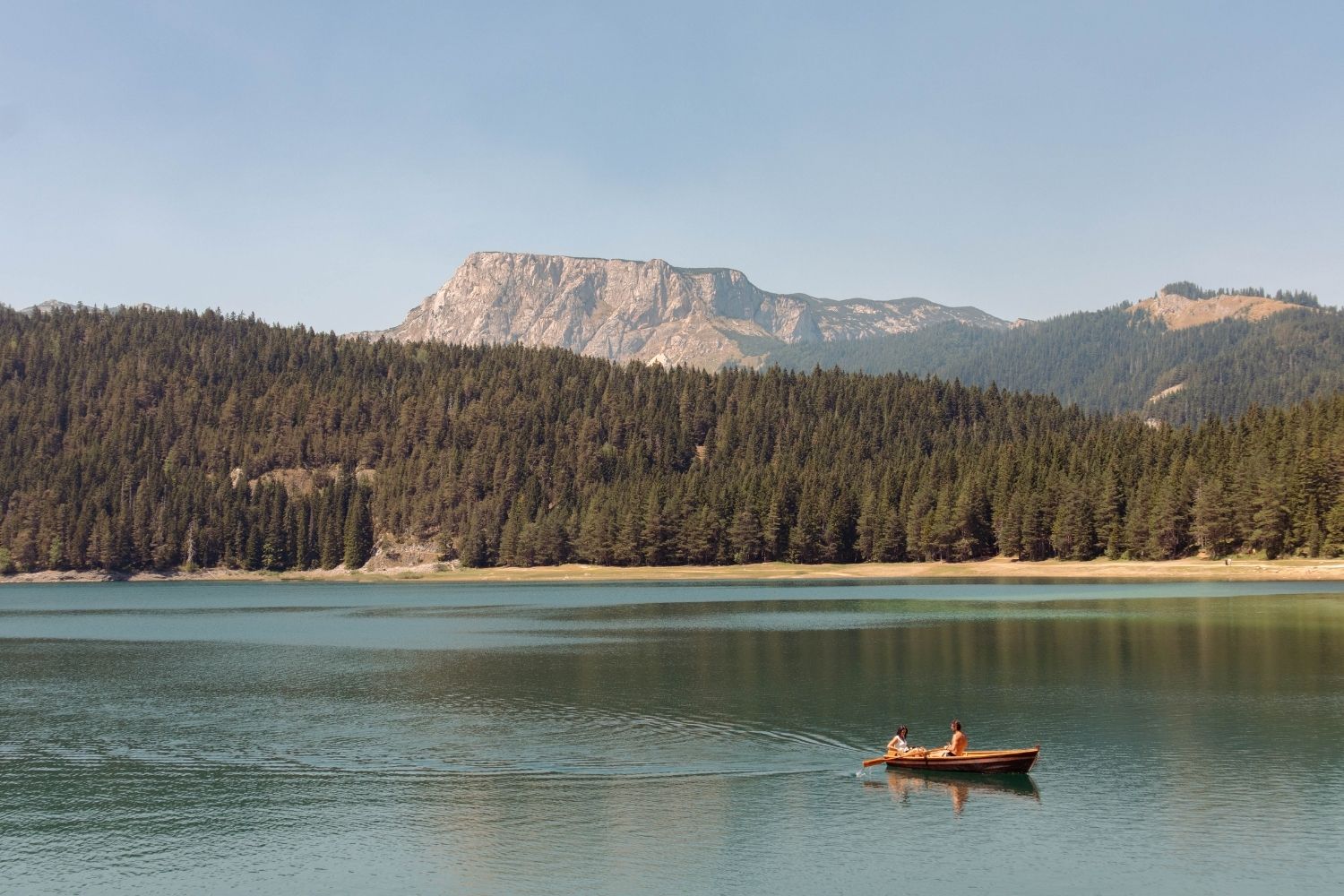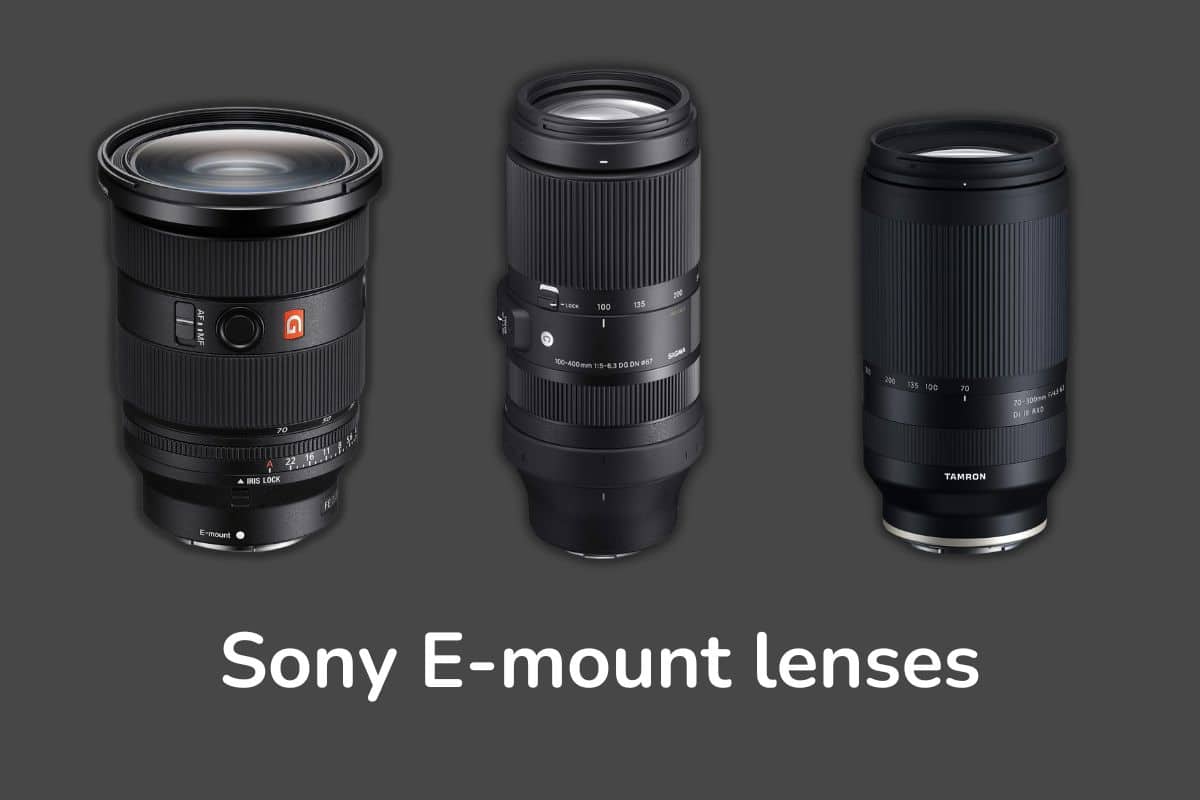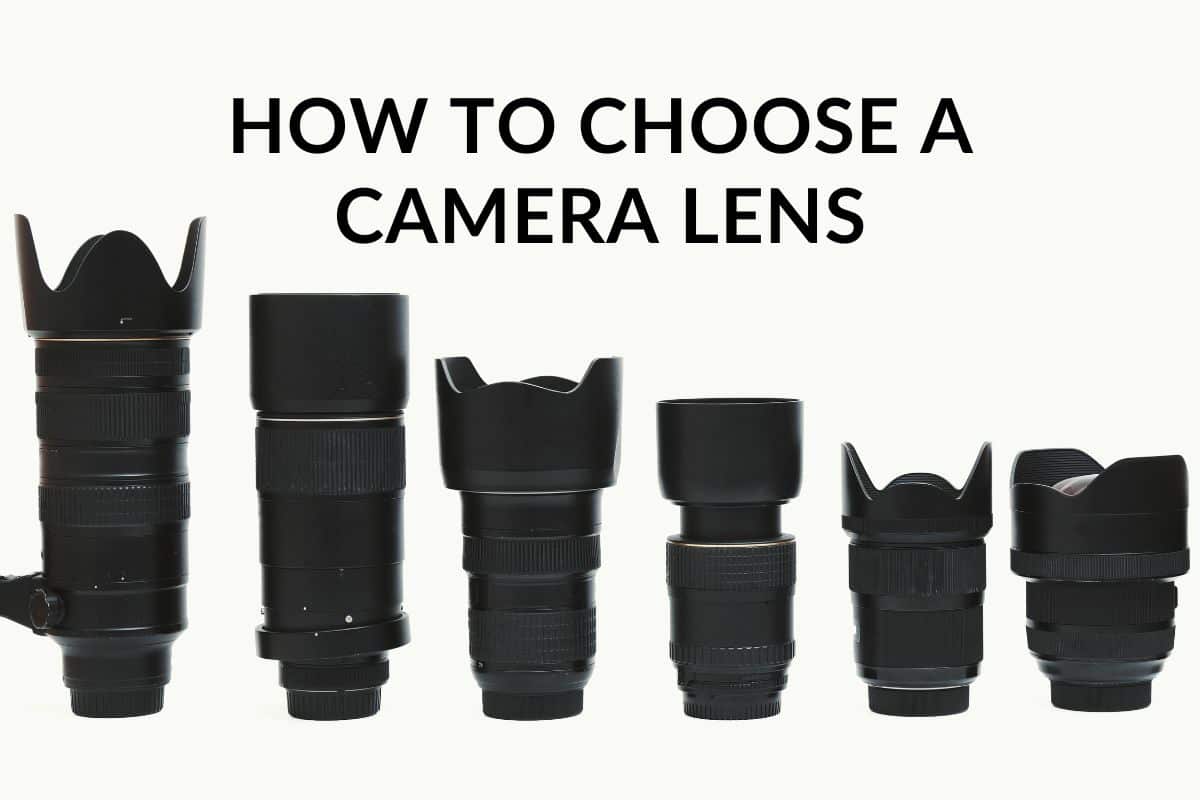The Sony a7 IV is a top-rated camera that I also use, and I am super pleased with its performance. It has lenses that cater to various photography needs and preferences.
This guide will explore the best lenses for Sony a7 IV, providing valuable insights into each lens’s build and handling, performance, focusing, and optimal use. Furthermore, I will compare lenses within the same class, helping you make an informed decision when choosing the perfect lens for your camera.
With this comprehensive overview, you’ll be well-equipped to select the ideal lens to enhance your photography experience and fully utilize the a7 IV’s remarkable capabilities.
Read more: How to Choose a Camera Lens That Fits Your Needs.
Disclosure: This article features affiliate links, including Amazon.com. If you decide to buy through one of these links, I’ll earn a small commission at no extra expense to you. For more details, please see my disclosure policy.
The list of best lenses for Sony a7 IV
| Lens name | Rating | Price |
|---|---|---|
| Sony FE 24-70mm f/2.8 G Master II | 4.8 (188) | Amazon |
| Tamron 28-75mm f/2.8 DI III RXD | 4.7 (873) | Amazon |
| Sony FE 85mm f/1.8 | 4.7 (628) | Amazon |
| Sony 55mm F1.8 Sonnar T FE ZA | 4.6 (460) | Amazon |
| Sigma 100-400mm F5-6.3 DG DN OS | 4.7 (526) | Amazon |
| Sony FE 200-600mm F5.6-6.3 | 4.7 (405) | Amazon |
| Sigma 14-24mm F2.8 DG DN Art | 4.5 (395) | Amazon |
| Sony FE 16-35mm f/2.8 GM | 4.7 (931) | Amazon |
| Sony FE 70-200mm f/2.8 GM OSS II | 4.7 (931) | Amazon |
| Tamron 70-180mm f/2.8 | 4.6 (590) | Amazon |
| Sony FE 20mm f/1.8 G | 4.7 (584) | Amazon |
| Sony FE 35mm f/1.8 | 4.6 (386) | Amazon |
There isn’t a single “best” lens that would universally cater to every photographer’s needs, as different lenses are designed for various categories and specialized applications. Some excel in portraiture, while others are optimized for landscape, wildlife, or sports photography. Each lens has unique strengths and characteristics, making it suitable for specific situations.
A standard zoom lens could be an excellent starting point if you’re uncertain about your primary field of interest or just starting your photography journey. These lenses offer versatility and cover a range of focal lengths, allowing you to experiment with different styles and subjects without investing in multiple specialized lenses.
As you refine your skills and discover your preferred photography niche, consider adding specialized lenses to your collection to enhance your capabilities in that specific area.
Below, we start with the standard zoom lenses and then seek portrait, wildlife, wide-angle, sports, and budget-friendly options.
Standard zoom lenses
1. Sony FE 24-70mm f/2.8 G Master II
- Price: Expert $$$
- Dimensions: 3.5 x 4.7 in / 87.8 x 119.9 mm
- Filter size: Ø82
- Weight: 24.6 oz / 695 g
- Maximum aperture: f/2.8
- Focal length: 24-70 mm
- Image stabilization: No

The Sony FE 24-70mm f/2.8 G Master II is a standard premium zoom ideal for professionals, providing high-quality images and excellent handling. Its relatively expensive price tag may be a barrier for some users, but it’s a fantastic investment for those who prioritize versatility and performance in their photography.
Build and handling: A dust and moisture-resistant design ensures optimum reliability and performance. This feature mainly benefits those who enjoy travel photography or outdoor shoots. This lens is relatively lightweight for a pro-grade at 24.6 ounces (695g), making it easy to carry around during extended shooting.
Performance: The lens boasts exceptional autofocus capabilities with four high-thrust XD linear motors. It also incorporates five aspherical elements, comprising two XA types, two ED, and two Super ED glass elements, yielding high-resolution imagery and minimal distortion.
Best for: The f/2.8 aperture is constant throughout the zoom range, providing deep, creamy bokeh and excellent close-up performance. This makes it suitable for various photography genres, such as portraits, landscapes, and events. With a 24-70mm focal length, it is ideal for both stills and video, making it an excellent travel lens.
Focusing: The lens has a minimum focus distance of 0.21m at the wide end and 0.3m at the telephoto end, providing a maximum magnification ratio of 0.32x. It also features an 11-blade circular aperture, contributing to smooth and beautiful bokeh in out-of-focus areas. The manual zoom system ensures precise control over your compositions.
This may be relatively expensive, but its features and build quality justify the price for those who require a professional-grade lens. Its focal lengths make it an excellent travel companion for both stills and video, and the lens’s durability ensures it can handle any shooting situation.
2. Tamron 28-75mm f/2.8 DI III RXD
- Price: Average $$
- Dimensions: 4.64 x 2.87 in. / 117.8 x 73 mm
- Filter size: Ø67
- Weight: 19.4 oz. / 550 g
- Maximum aperture: f/2.8
- Focal length: 28 – 75 mm
- Image stabilization: No
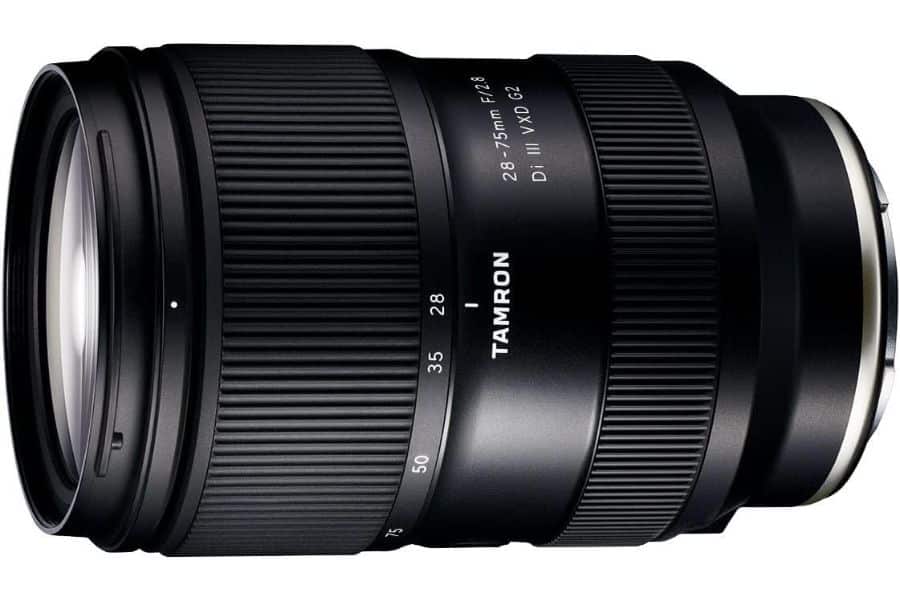
The Tamron 28-75mm f/2.8 DI III RXD is a budget-friendly lens designed for versatile needs. As a more affordable alternative to the Sony FE 24-70mm f/2.8 G Master II, it offers an excellent balance of build quality, handling, performance, and focusing for photographers who want a reliable zoom lens without breaking the bank.
Build and handling: Its compact and lightweight design makes it a suitable travel companion. Weighing 19.4 oz (550g), it is lighter than the Sony G Master II, making it easier to carry around during extended shooting sessions. Its optical construction consists of 15 elements in 12 groups, and it features a 67mm filter size and a maximum diameter of 73mm.
Performance: The Tamron lens provides excellent image quality with its constant f/2.8 aperture throughout the zoom range. The lens produces a pleasing bokeh with nine circular diaphragm blades, although it might not be as smooth as the 11-blade aperture of the Sony G Master II. The lens has a minimum object distance of 7.5 in (0.19m) at the wide end and 15.3 in (0.39m) at the telephoto end, with a maximum magnification ratio of 1:2.9 (wide) / 1:4 (tele).
Focusing: It’s fast and accurate, thanks to the RXD (Rapid eXtra-silent stepping Drive) motor, which ensures silent and precise autofocus performance. This is particularly beneficial for both stills and video shooting, where noise-free focusing is essential.
Best for: It’s an ideal choice for starting travel photographers, as it offers an affordable option with good image quality and a versatile focal length range. Its drawbacks include a slightly less robust build than the Sony G Master II and potentially less smooth bokeh due to fewer aperture blades.
Comparison: The main differences between the Tamron 28-75mm f/2.8 DI III RXD and the Sony FE 24-70mm f/2.8 G Master II are price, weight, and build quality. While the Tamron lens is lighter and more affordable, the Sony G Master II boasts a more robust build and arguably superior image quality due to its advanced optical elements. However, the Tamron lens provides more than adequate performance for many photographers at a significantly lower price point.
Overall, the Tamron 28-75mm f/2.8 DI III RXD is a solid, budget-friendly option for photographers looking for a versatile camera lens. Good build quality, handling, and performance make it one of the best travel lenses for starters.
portrait lenses
3. Sony FE 85mm f/1.8
- Price: Budget $
- Dimensions: 3.07 x 3.23 in / 78 x 82 mm
- Filter size: Ø67
- Weight: 13.1 oz / 371 g
- Maximum aperture: f/1.8
- Focal length: 85 mm
- Image stabilization: No
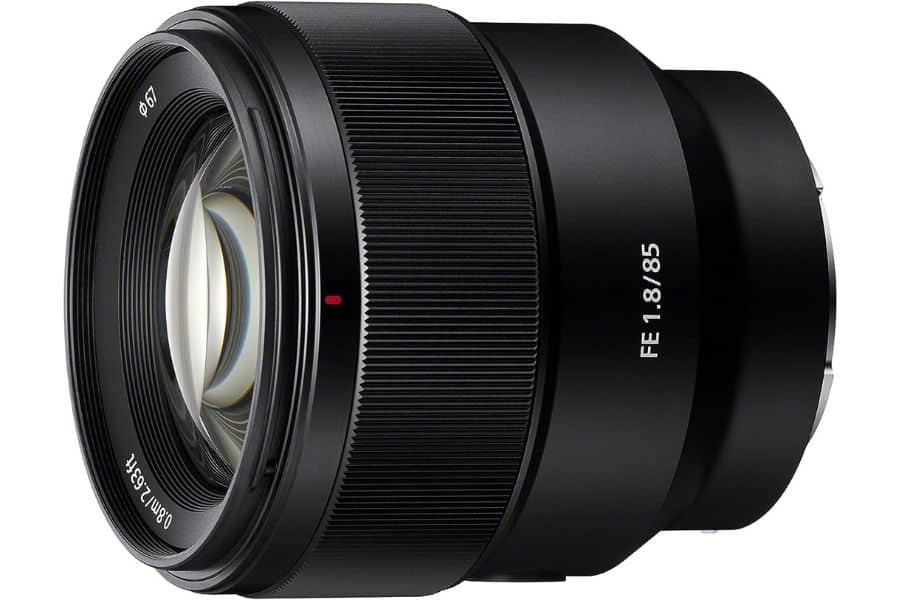
The Sony FE 85mm f/1.8 is a mid-range telephoto prime lens. It provides an excellent budget-friendly option for portrait photography, and its performance-price ratio makes it ideal for beginners.
Build and handling: The portrait lens features a dust and moisture-resistant design, ensuring durability and reliability in various shooting conditions. Weighing only 13.1 oz (371g), this lightweight lens is easy to handle during extended shooting sessions. Its compact size of 3.07 x 3.23 inches (78 x 82 mm) makes it an excellent addition to your camera bag without adding much bulk.
Performance: The Sony FE 85mm f/1.8 utilizes ED (Extra-low Dispersion) glass to compensate for chromatic aberrations, delivering sharp and high-quality images. With a maximum aperture of f/1.8, the lens provides excellent low-light capabilities and beautiful background separation, creating stunning portraits with a shallow depth of field. The circular 9-blade aperture contributes to a pleasing bokeh, further enhancing the defocus effect in your images.
Focusing: Thanks to the linear motor system, it’s precise and quiet. This ensures accurate focus without disturbing your subject or drawing attention during video recording. However, it’s worth noting that this lens does not have built-in image stabilization, relying on the a7 IV’s body-integrated SteadyShot system for stabilization.
Pros and Cons: The portrait lens’s pros include its budget-friendly price, excellent image quality, compact size, and lightweight design. Its cons may include the lack of built-in image stabilization and the potential for chromatic aberration in high-contrast situations, although the ED glass helps minimize this issue.
Best for: It’s an ideal lens for beginner portrait photographers, offering a budget-friendly option without compromising image quality or performance. With a suitable focal length for portrait photography and a fast f/1.8 aperture, this lens allows you to explore the creative depth of field and lighting techniques easily. Its lightweight and compact design makes it a convenient choice for on-the-go shooting.
In conclusion, the Sony FE 85mm f/1.8 is one of the best lenses for portraits at a very affordable price point. With impressive performance, build quality and handling, this lens is a valuable addition to any beginner’s photography kit.
4. Sony 55mm F1.8 Sonnar T FE ZA
- Price: Average $$
- Dimensions: 2.54 x 2.76 in x 64.4 x 70.5 mm
- Filter size: Ø49
- Weight: 10 oz / 281 g
- Maximum aperture: f/1.8
- Focal length: 55 mm
- Image stabilization: No
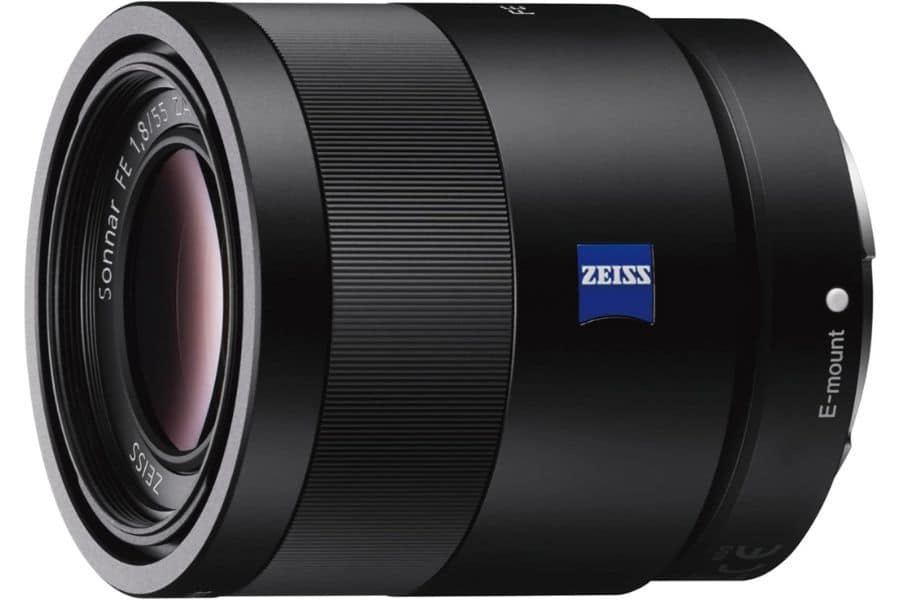
The Sony 55mm F1.8 Sonnar T FE ZA is a full-frame, standard prime lens offering excellent build quality, handling, performance, and focus. Although more expensive than the Sony FE 85mm f/1.8, it is another fantastic option for beginner portrait photographers looking for a versatile, high-quality lens.
Build and handling: It features a dust- and moisture-resistant design, ensuring durability and reliability in various shooting conditions. Weighing only 10 oz (281g), this lens is lightweight and easy to handle. Its compact size of 2.54 x 2.76 inches (64.4 x 70.5 mm) also doesn’t take up much space in the camera bag.
Performance: As the previous option, it boasts a bright F1.8 maximum aperture, providing excellent low-light capabilities and background separation for stunning portraits. The lens also features a circular 9-blade aperture for beautiful defocus effects, similar to the Sony FE 85mm f/1.8. The ZEISS T* anti-reflective coating minimizes flare and ghosting, ensuring high-contrast and clear images.
Focusing: This Zeiss portrait lens’s focus is precise and smooth, although it may not be as quiet as the linear motor found in the Sony FE 85mm f/1.8. However, it is good enough for stills and video shooting, providing accurate focus and stunning image quality.
Best for: While the Sony 55mm F1.8 Sonnar T FE ZA is more expensive than the FE 85mm, it offers a different focal length and is more versatile for various photography genres beyond portrait photography. The shorter focal length allows for more environmental context in your portraits, making it ideal for lifestyle or documentary-style portraits.
Comparison: Comparing the Sony 55mm F1.8 Sonnar T FE ZA to the Sony FE 85mm f/1.8, the main differences are the focal length, price, and lens coatings. The 55mm lens is more expensive and offers a shorter focal length, making it a more versatile option for various photography genres. The ZEISS T* coating on the 55mm lens provides better flare and ghosting resistance, further enhancing image quality.
In conclusion, the Sony 55mm F1.8 Sonnar T FE ZA is a superb lens for beginner portrait photographers using the a7 IV camera, despite being more expensive than the Sony FE 85mm f/1.8.
wildlife lenses
5. Sigma 100-400mm F5-6.3 DG DN OS
- Price: Average $$
- Dimensions: 3.4 x 7.8 in. / 86.0 x 199.2 mm
- Filter size: Ø67 mm
- Weight: 40.2 oz. / 1,140 g
- Maximum aperture: f/5
- Focal length: 100 – 400 mm
- Image stabilization: Yes
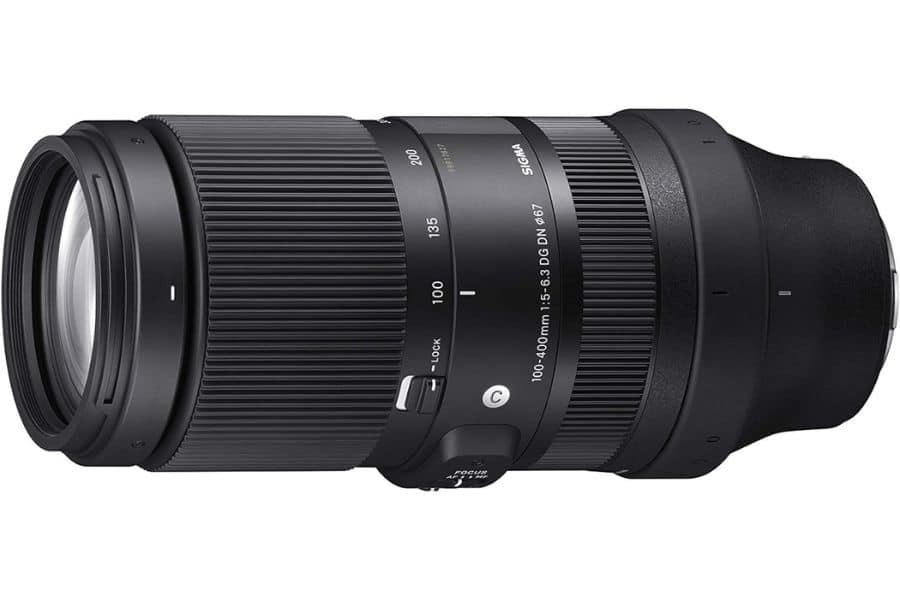
This Sigma 100-400mm F5-6.3 DG DN OS is an affordable option in the superzoom lens category, making it attractive for those interested in wildlife, sports, or other photography genres requiring extended reach.
Build and handling: The Sigma lens for a7 IV features robust construction with 22 elements in 16 groups, ensuring durability and reliability. Weighing 40.2 oz (1,140g), this lens is relatively lightweight in this class, making it easier to handle during extended shooting sessions. The lens measures 3.4 inches (86.0mm) in diameter and 7.84 inches (199.2mm), providing a compact form factor considering its impressive zoom range.
Performance: Sigma 100-400mm delivers sharp, detailed images throughout its zoom range, thanks to its advanced optical construction. The lens features a minimum focusing distance of 3.67ft (112cm) for wide and 5.25 ft (160cm) for tele, allowing you to get relatively close to your subjects. With a maximum magnification ratio of 1:4.1 at 400mm, it can capture close-up shots with impressive detail. The rounded 9-blade diaphragm ensures smooth and pleasing bokeh.
Focusing: Sigma lens focusing is quick and accurate, making it suitable for fast-moving subjects like wildlife or sports events. The lens features built-in Optical Stabilization (OS), ensuring sharper images when shooting handheld or in low-light conditions.
Best for: This telephoto lens is ideal for wildlife photography, offering an extensive zoom range that allows you to capture subjects from a distance without disturbing their natural behavior. While its maximum aperture may not be as fast as other options, it still provides good low-light performance and background separation when used at longer focal lengths.
In conclusion, the Sigma 100-400mm F5-6.3 DG DN OS is a versatile and affordable superzoom lens for your full-frame Sony camera. It is an excellent choice for those interested in wildlife, sports, or other photography genres requiring extended reach. This lens is valuable to any photographer’s kit, particularly those seeking a cost-effective superzoom option.
6. Sony FE 200-600mm F5.6-6.3
- Price: Expert $$$
- Dimensions: 4.39 x 12.52 in. / 111.5 x 318 mm
- Filter size: Ø95
- Weight: 4.65 lb / 2115 g
- Maximum aperture: f/2.8
- Focal length: 200-600 mm
- Image stabilization: Yes
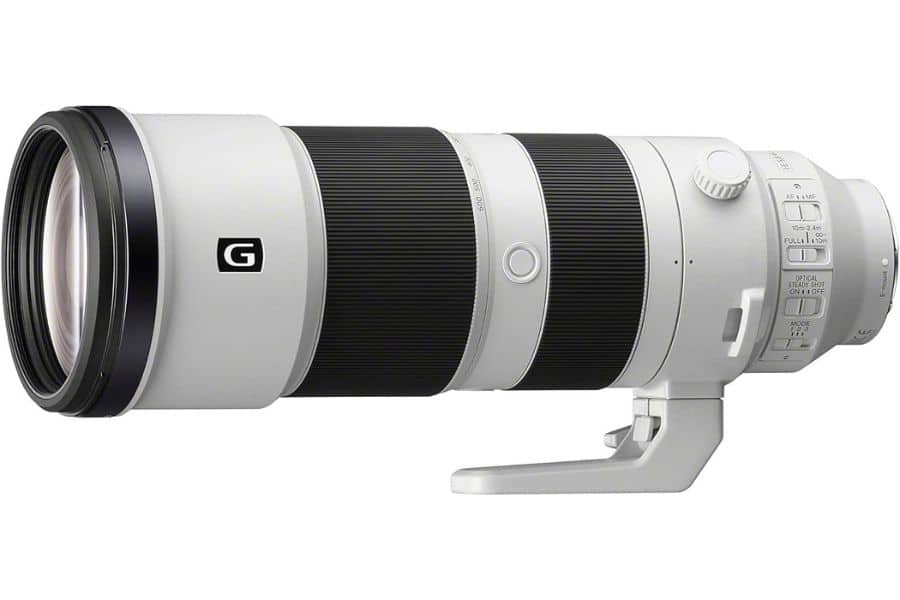
It is an ideal lens for wildlife photography, sports, and other situations requiring a long reach. However, this lens is more expensive than the previous Sigma 100-400mm, making it a premium choice for those willing to invest in a high-quality telephoto lens.
Build and handling: The Sony FE 200-600mm F5.6-6.3 G OSS lens features sturdy construction with 17 groups and 24 elements, including an aspherical element and five ED glasses, ensuring optimal image quality throughout the entire zoom range. The wildlife lens also features a dust- and moisture-resistant design, making it suitable for various weather conditions. This lens is considerably larger and heavier than the previous Sigma telephoto lens at 4.39 x 12.52 inches (111.5 x 318 mm) and 74.7 ounces (2115 g).
Performance: The Sony FE 200-600mm lens delivers sharp and detailed images, thanks to its advanced optical design and Sony Nano AR Coating, which helps to eliminate flare and ghosting. The lens features an 11-blade circular aperture, creating a smooth and pleasing bokeh. With a minimum focus distance of 7.88 ft (2.4 m) and a maximum magnification ratio of 0.2x, this lens allows you to capture close-up shots while maintaining a safe distance from your subject.
Best for: The wildlife lens features a Direct Drive SSM (Super Sonic Wave Motor) for quiet and precise autofocus control, making it suitable for capturing fast-moving subjects like wildlife and sports. Additionally, the lens includes Optical SteadyShot image stabilization, ensuring sharper images when shooting handheld or in low-light conditions.
Comparison: The Sony FE 200-600mm F5.6-6.3 G OSS lens is more expensive than the Sigma 100-400mm F5-6.3 DG DN OS. The Sony lens has a more extended zoom range and improved build quality. It is ideal for wildlife photography due to its extensive zoom range, which allows photographers to capture subjects from a greater distance without disturbing their natural behavior.
In conclusion, it’s one of the best lenses if your field is wildlife photography or other genres requiring a long reach. While it is more expensive than the Sigma 100-400mm F5-6.3 DG DN OS, the Sony lens offers an extended zoom range, superior build quality, and enhanced performance, making it a worthwhile investment for serious photographers who demand the best results.
wide-angle lenses
7. Sigma 14-24mm F2.8 DG DN Art
- Price: Average $$
- Dimensions: 3.35 x 5.16 in. / 85 x 131 mm
- Filter size: Rear holder
- Weight: 28.04 oz. / 795 g
- Maximum aperture: f/2.8
- Focal length: 14-24 mm
- Image stabilization: No

It’s a high-quality wide-angle zoom lens with a constant f/2.8 aperture, exceptional optical performance, and robust build, making it a popular choice for photographers seeking a versatile wide-angle lens for various shooting situations.
Build and Handling: The lens construction features 18 elements in 13 groups, ensuring a robust and durable design. With a relatively compact size and a weight of 28.04 ounces (795g), the Sigma lens is comfortable to handle. Its weather-sealed construction offers protection against dust and moisture, adding to its reliability and durability in different shooting environments.
Performance: This lens excels with its constant f/2.8 aperture, which provides excellent low-light capabilities and depth-of-field control. The lens delivers sharp, high-resolution images with minimal distortion across the entire focal range. The advanced optical design ensures edge-to-edge sharpness, while high-quality glass elements reduce chromatic aberrations and other optical issues.
Best for: This wide-angle lens is ideal for various photographic situations, including landscape, architectural, interior, and astrophotography. It’s versatility and outstanding performance make it a valuable addition to any photographer’s kit.
Focusing: Featuring a high-speed autofocus system, the Sigma 14-24mm provides fast, accurate, and quiet focusing performance. This makes the lens suitable for both still photography and videography. The minimum focusing distance of 11.02 inches (28cm) allows for creative close-up shots, while the maximum magnification ratio of 1:7.3 offers flexibility in capturing subjects.
In conclusion, the wide-angle lens offers excellent build quality, impressive optical performance, and a fast autofocus system. Its versatility makes it suitable for various wide-angle photography situations.
8. Sony FE 16-35mm f/2.8 GM
- Price: Expert $$$
- Dimensions: 3.48 x 4.79 in. / 88.5 x 121.6 mm
- Filter size: Ø82
- Weight: 24 oz. / 680 g
- Maximum aperture: f/2.8
- Focal length: 16-35 mm
- Image stabilization: No
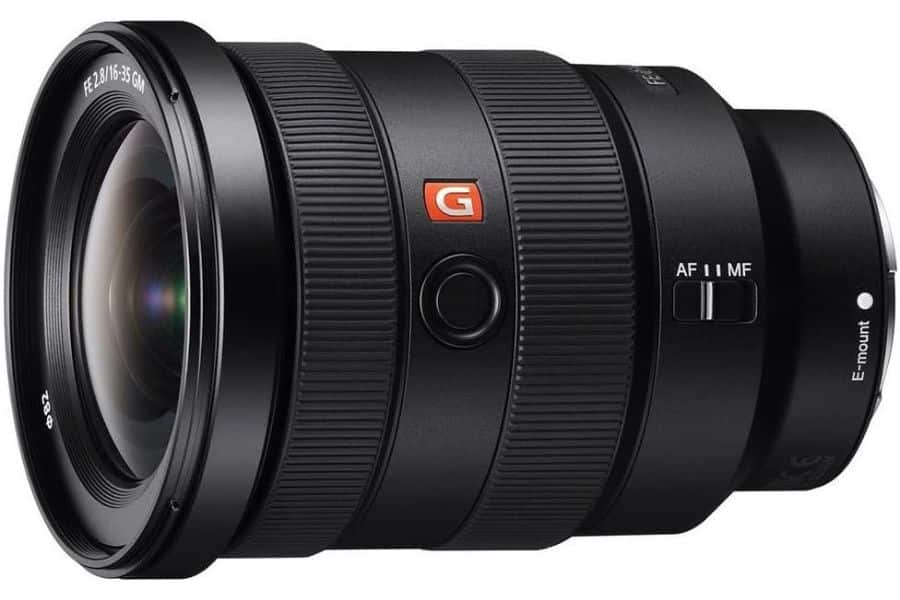
The Sony FE 16-35mm f/2.8 GM is a premium wide-angle zoom lens that delivers exceptional performance across various photographic fields. It is part of Sony’s G Master series and boasts remarkable resolution, beautiful bokeh, and excellent build quality.
Build and handling: It features a dust and moisture-resistant design that ensures durability and reliability in various shooting conditions. The lens incorporates two XA (extreme aspherical) elements that deliver outstanding resolution, while the circular 11-blade aperture contributes to beautiful defocus effects. The Sony Nano AR Coating helps eliminate flare and ghosting, ensuring clean, crisp images. Weighing in at 24 ounces (680g), it is slightly lighter than the previous Sigma lens.
Performance: The constant f/2.8 aperture delivers excellent low-light capabilities and depth-of-field control. At the same time, the lens’s two XA (extreme aspherical) elements ensure outstanding resolution across the zoom range. The 11-blade circular aperture contributes to beautiful defocus effects, and Sony’s Nano AR Coating minimizes flare and ghosting.
Focusing: Its Direct Drive SuperSonic Motor (DDSSM) ensures quiet and precise autofocus, working seamlessly with the Sony a7 IV’s advanced capabilities. The lens captures images with depth and perspective with a minimum focus distance of 0.92 ft (0.28m) and a maximum magnification ratio of 0.19x. The smooth manual focus ring offers precise control, improving the lens’s performance in wide-angle situations.
Best for: It excels in landscape photography, easily capturing wide vistas and dramatic scenes. Additionally, it is an excellent choice for architectural photography, enabling photographers to capture the details and scale of structures. The lens is also suitable for street photography, event coverage, and environmental portraits.
Comparison: When comparing the two lenses, the Sony FE 16-35mm f/2.8 GM offers a slightly wider zoom range, allowing for more flexibility in composition. The build quality and weather-sealing of the Sony lens are also on par with the Sigma counterpart. However, the Sigma 14-24mm F2.8 DG DN Art has a slightly wider field of view at the wide end, which might be more appealing to some photographers. Also, the Sony Sony FE 16-35mm f/2.8 GM is pricier than the Sigma lens.
While it is more expensive than the Sigma 14-24mm, the Sony lens offers a more versatile zoom range and shares similar build quality and performance features.
sports lenses
9. Sony FE 70-200mm f/2.8 GM OSS II
- Price: Expert $$$
- Dimensions: 3.46 x 7.87 in. / 88 x 200 mm
- Filter size: Ø77
- Weight: 36.9 oz. / 1045 g
- Maximum aperture: f/2.8
- Focal length: 70-200 mm
- Image stabilization: Yes

As a part of Sony’s G Master series, the Sony FE 70-200mm f/2.8 GM OSS II is favored by many professional photographers for its versatility and performance. Ideal for sports, wildlife, and event photography, it combines an impressive range of features to meet the demands of high-end shooting scenarios.
Build and handling: Its construction features weather-sealing, ensuring durability and reliability even in challenging conditions. The lens is ergonomically designed for comfortable use during long shooting sessions, and its focus and zoom rings are smooth and precise, allowing for easy adjustments. Despite being a pro-grade lens, its weight of 36.9 ounces (1045g) is manageable and feels well-balanced on the camera.
Performance: This Sony lens boasts excellent image quality throughout the zoom range and at all focusing distances. The advanced optical design with two aspherical elements, one XA type, and several ED glass elements minimizes chromatic aberration and ensures high resolution. The Nano AR Coating II helps suppress flare and ghosting, enhancing image quality.
The lens produces exquisite bokeh, with an F2.8 aperture and an 11-blade aperture unit contributing to the beautiful and soft background. Its minimum focusing distance of 1.32 feet (0.4m) at 70mm and 2.69 feet (0.82m) at 200mm allows for stunning close-up shots.
Focusing: The FE 70-200mm f/2.8 GM OSS II features a fast, precise autofocus system utilizing four XD linear motors for enhanced AF speed and accuracy. This makes it perfect for sports photography or capturing fast-moving subjects. Additionally, the lens is compatible with 1.4x and 2x teleconverters, further extending its versatility.
Best for: Despite being a more expensive option, many professionals favor the Sony FE 70-200mm f/2.8 GM OSS II for its outstanding performance and capabilities. It is an ideal lens for photographers who demand the best image quality and performance, particularly those specializing in sports, wildlife, or event photography.
With impressive build, performance, and focusing abilities, this lens is a worthy investment for professionals or advanced amateurs seeking top-tier results.
10. Tamron 70-180mm f/2.8
- Price: Average $$
- Dimensions: 3.2 x 5.9 in. / 81 x 149 mm
- Filter size: Ø67 mm
- Weight: 1.78 lb / 810 g
- Maximum aperture: f/2.8
- Focal length: 70 – 180 mm
- Image stabilization: Yes
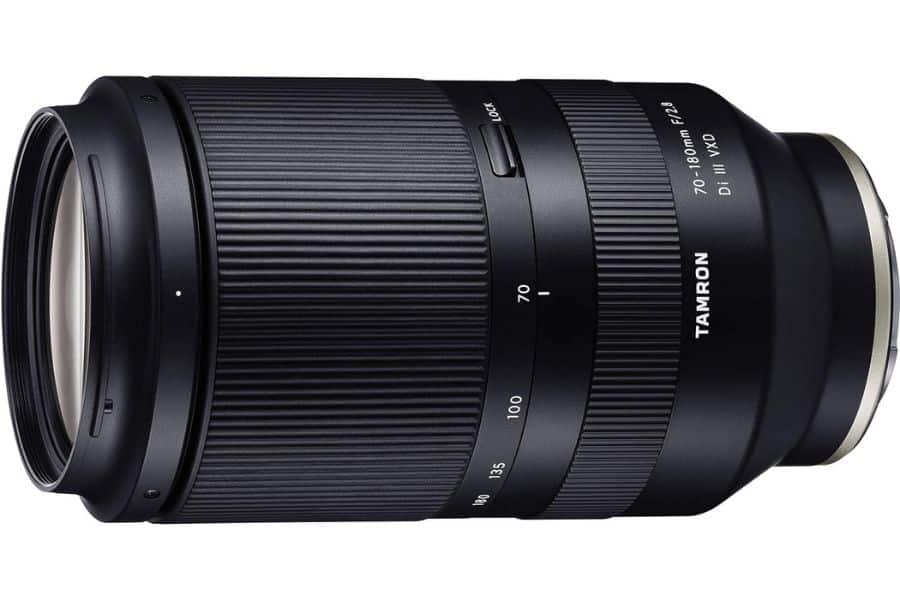
The Tamron 70-180mm f/2.8 is a versatile telephoto zoom lens with a compact design and a fast f/2.8 aperture. Its impressive portability and performance make it suitable for various photography fields.
Build and handling: Its innovative zoom mechanism allows for a reduced size while maintaining an f/2.8 aperture, resulting in a portable telephoto zoom lens that’s easy to handle. Weighing 28.6 oz (810g) and measuring 5.9 in (149mm) in length, the lens shares a 67mm filter diameter with other Tamron full-frame mirrorless lenses, streamlining filter management.
Performance: The Tamron lens boasts exceptional image quality thanks to its 19 elements in 14 groups, including specialized lens elements like XLD, LD, GM, and hybrid aspherical elements. The lens also features Tamron’s BBAR-G2 Coating to suppress ghosting and flare, ensuring images with high contrast and sharpness across the entire zoom range. This lens can capture powerful close-up images with a minimum object distance of 33.5 in. (0.85m) and a maximum magnification ratio of 1:4.6.
Focusing: The lens focusing is quick and precise, thanks to the newly-developed VXD linear motor AF drive focus mechanism. This design ensures high-speed autofocus and focus tracking, making it ideal for sports and racing photography. Its quiet operation also makes it suitable for shooting in low-noise environments.
Comparison: When comparing the Tamron 70-180mm f/2.8 and Sony FE 70-200mm f/2.8 GM OSS II lenses, the Tamron offers a compact, lightweight design and lower cost, making it an affordable and portable option. However, it has a shorter focal length range and lacks built-in image stabilization. On the other hand, the Sony lens boasts a pro-grade build, built-in image stabilization, and a slightly longer focal length range, providing more versatility. However, it comes at a higher cost and increased weight.
In conclusion, the Tamron lens is an excellent choice for photographers seeking a high-quality, affordable telephoto zoom lens with a compact form factor. Its remarkable optical performance makes it an attractive option for various photography applications.
budget lenses
11. Sony FE 20mm f/1.8 G
- Price: Average $$
- Dimensions: 2.89 x 3.33 in. / 73.5 x 84.7 mm
- Filter size: Ø67
- Weight: 13.2 oz. / 375 g
- Maximum aperture: f/1.8
- Focal length: 20 mm
- Image stabilization: No
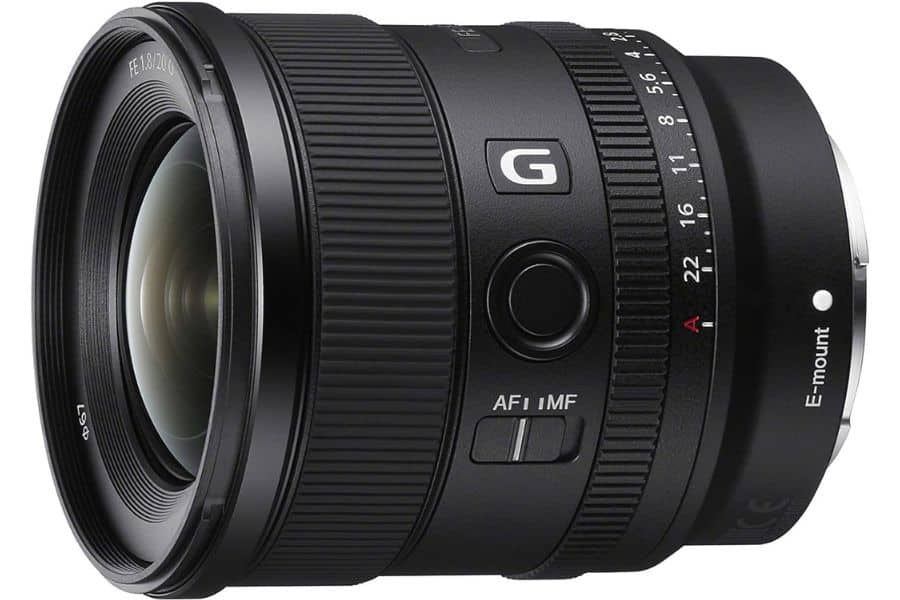
The Sony FE 20mm f/1.8 G is an outstanding choice for photographers and videographers who want a reliable, high-quality ultra-wide-angle lens without breaking the bank.
Build and handling: It has a robust construction and ergonomic design. It features a durable build with high-quality materials, ensuring reliability and longevity. The focus hold button and other professional shooting features enhance its usability. It’s compact size and lightweight design, measuring 2.89 x 3.33 inches (73.5 x 84.7mm) and weighing 13.16 oz (373g), make it easy to handle and perfect for on-the-go photography.
Performance: This budget Sony lens delivers exceptional optical performance thanks to its sophisticated design that includes two AA elements and three ED glasses. These components ensure high resolution across the entire image area, producing sharp, detailed images. The Sony Nano AR Coating eliminates flare and ghosting, enhancing image quality. The f/1.8 maximum aperture provides excellent low-light capabilities and depth-of-field control, making it suitable for various photography styles.
Focusing: Equipped with an XD Linear Motor, the Sony FE 20mm f/1.8 G lens offers fast, precise, and quiet autofocus performance. This motor ensures excellent response and low vibration, making it ideal for stills and video recording. The minimum focus distance of 7.09 inches (18cm) allows for close-up shots with a maximum magnification of 0.2x.
Best for: The wide angle of view makes the affordable lens perfect for various photography fields, such as landscapes, architecture, and interiors. Its fast aperture and excellent low-light performance make it suitable for astrophotography and event photography. Its budget-friendly price and quiet autofocus capabilities make it an attractive option for vlogging.
The Sony FE 20mm f/1.8 G is a versatile, high-quality wide-angle prime lens that delivers exceptional performance across various photography styles. Its budget-friendly nature makes it an excellent choice for photographers and vloggers.
12. Sony FE 35mm f/1.8
- Price: Average $$
- Dimensions: 2.58 x 2.87 in. / 65.6 x 73 mm
- Filter size: Ø55
- Weight: 9.9 oz. / 280 g
- Maximum aperture: f/1.8
- Focal length: 35 mm
- Image stabilization: No
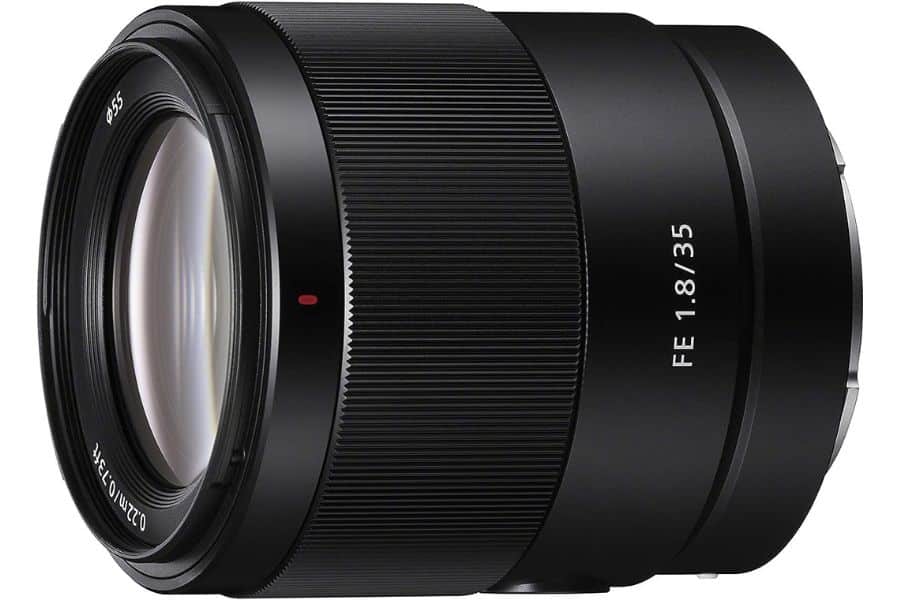
The Sony FE 35mm f/1.8 is a compact, lightweight standard prime lens with excellent build and handling characteristics. Its fast F1.8 aperture makes it perfect for low-light photography situations and achieving beautiful bokeh effects.
Build and handling: Weighing 9.9 ounces (280g) and featuring a dust and moisture-resistant design, this lens ensures durability in various shooting environments. The Sony FE 35mm f/1.8 includes a focus hold button, a focus mode switch, and a 55mm filter on the front element for added convenience. Its petal-shaped, bayonet-type lens hood helps minimize flare and protects the front element.
Performance: It features a 9-blade circular aperture, which provides a pleasing background blur and an aspherical element that ensures high corner-to-corner resolution. This lens has 11 elements in 9 groups, delivering consistently sharp, high-quality images across its aperture range.
Focusing: Sony FE 35mm f/1.8 focusing is quiet and reliable, ideal for shooting movies and stills. The lens features a linear-motor AF drive system that ensures fast, precise, and silent autofocus performance. The body-integrated stabilization offered by the a7 IV camera compensates for the absence of image stabilization.
Best for: Affordable lens excels in various photography fields, including portraits, street photography, and landscapes. Its 35mm focal length makes it versatile for different shooting situations. The lens’s minimum focus distance of 0.73 feet (0.22m) and maximum magnification ratio of 0.24x also make it suitable for close-up photography.
Its compact size, lightweight design, and compatibility with various photography fields make it an ideal choice for photographers and videographers.
Conclusion
The Sony a7 IV camera provides many lens options for various photography needs. With choices ranging from standard zooms to wide-angle primes and telephoto lenses, finding the best lens for a Sony a7 IV camera ultimately depends on your specific requirements, whether it be portraits, real estate, wildlife, or other photography genres. If you’re unsure which lens to choose, a standard zoom lens is a versatile option that covers multiple needs, making it an excellent starting point.
By carefully considering your photography interests and style, you can select the perfect lens to complement the capabilities of your camera and elevate your photography experience.
PIN IT
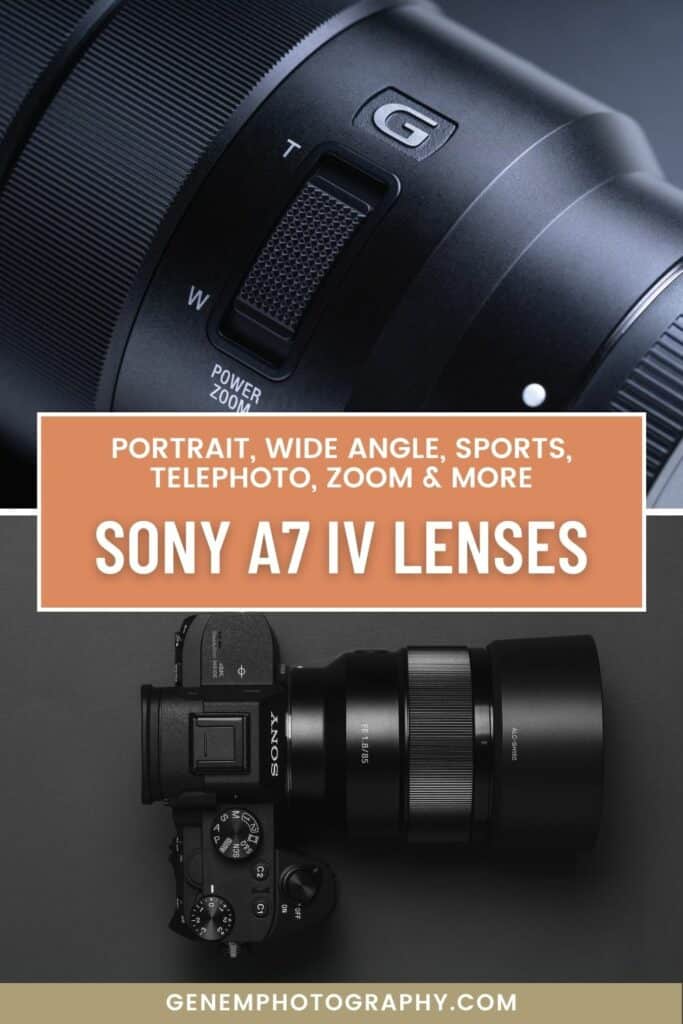
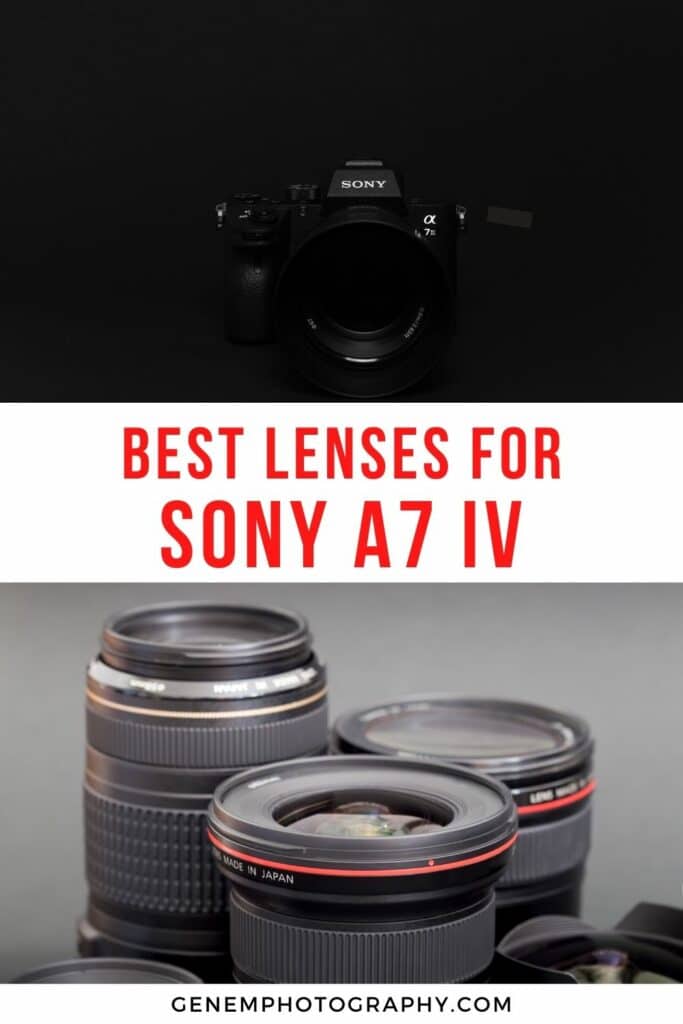
More Sony lenses:
